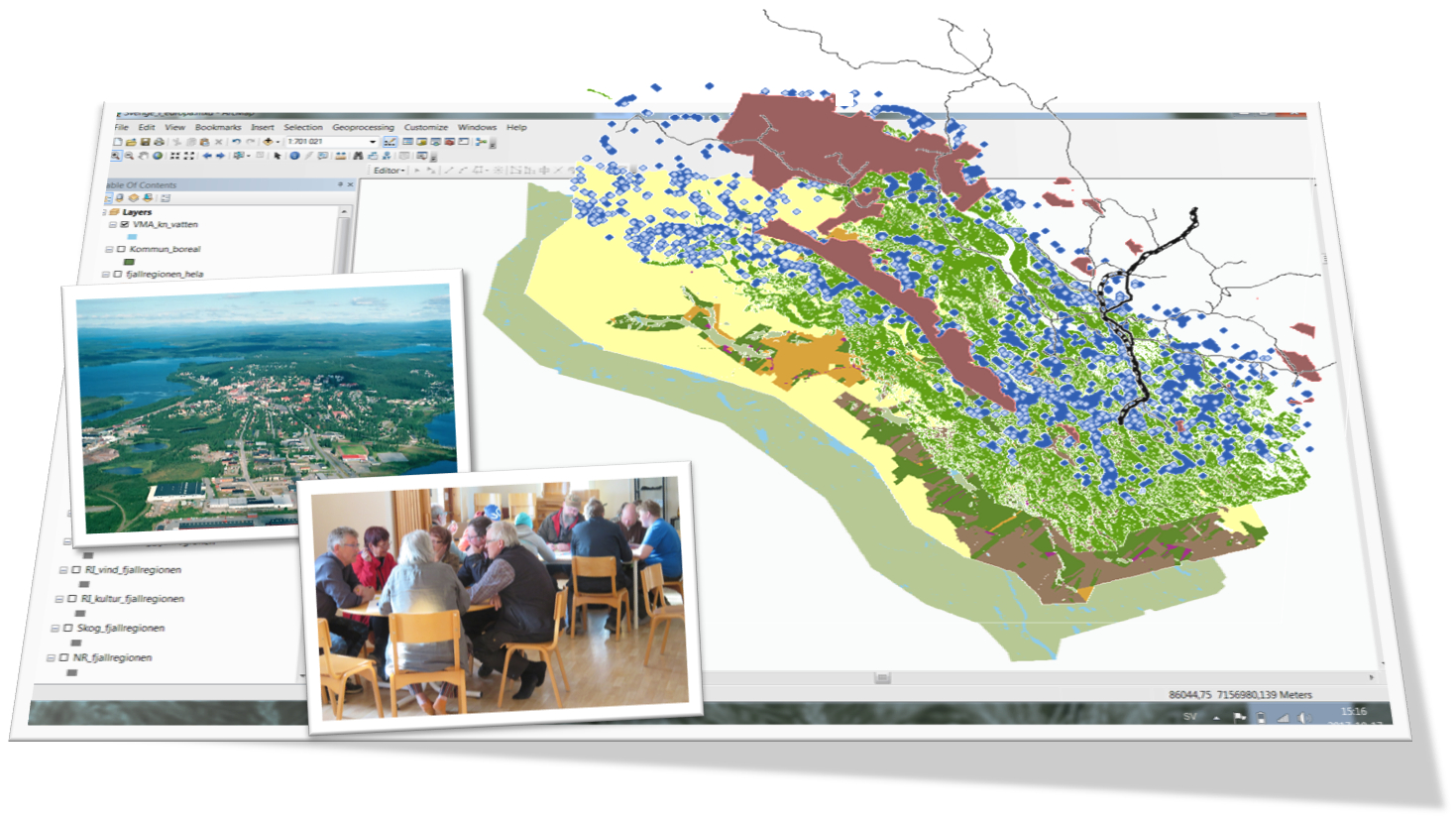The use of local natural resources, particularly forest resources, are important for many rural municipalities. Municipal spatial planning is a key tool in finding a balance between ecological, social and economic sustainability in social development based on a landscape perspective on utilization. Dialogue and stakeholder interaction in the planning, based on comprehensive and shared knowledge of different types and aspects of local land use, create better conditions for acceptance and implementation of planning. Based on the statutory ambition of municipal comprehensive planning (MCP), this introduction is an ideal description of the situation in Sweden’s boreal rural municipalities. There are several different obstacles that make the description an ideal in most cases, but there is also potential for changing.
Combining four case studies of land use and municipal comprehensive planning in Sweden’s fifteen mountain municipalities, of which Vilhelmina municipality has been used as an example, as well as in nine municipalities of Bergslagen, the conditions for strategic work for sustainable development in Swedish boreal rural municipalities have been studied. Rural municipalities are defined as geographically extensive, sparsely populated municipalities with large forest areas and abundant natural resources. The studies were conducted in the form of surveys, interviews and analyzes using geographic information systems (GIS). The purpose was to create knowledge about municipal comprehensive planning as well as local natural resources and companies such as forest and forest owners. This layout showed difficulties and opportunities with municipal comprehensive planning and how local knowledge, GIS and geographic information about land use can support, generate important knowledge for and develop municipal comprehensive planning.
The forest is an important resource for rural communities
The first case study of the project shows that the local natural resources play an important role in the local (small) business in a rural community. Eight out of ten entrepreneurs in Vilhelmina municipality operated one or more activities where natural resources and access to these were of great importance. Nearly half of the companies had their main business in forestry. Together, these companies employed a relatively large proportion of the working population. Most of the companies also had a strong and stable connection with the municipality. Overall, the study indicated a clear link between individuals, municipalities and companies with activities dependent on local natural resources, including forest resources. This knowledge is of great importance for the pursuit of social, economic and ecological sustainable development at local level.
Municipal planning falls behind and the forest is not visible
The following two case studies in the mountain municipalities and in Bergslagen show difficulties in municipal comprehensive planning in Swedish rural municipalities to capture and handle all the information that would potentially be required for a more inclusive and efficient planning process. This includes a more holistic landscape perspective that includes the available natural resources – including the forest.
Comprehensive planning is, in most cases, not the dynamic, inclusive and communicative process referred to in the Act, as desired by stakeholders in planning and land use actors. Resource shortage and the challenge it involves dealing with a variety of complex issues over a large geographical area makes many municipalities difficult to plan with a real landscape perspective. Despite their obvious presence in the social, economic and ecological landscape, forests and forest owners are invisible in the municipal planning. To increase the motivation to concentrate on comprehensive planning, municipalities, but also concerned land users and municipal citizens, need a higher impact in and of the planning. In order to increase commitment and involvement in comprehensive planning, the planning needs to handle, and be allowed to handle, issues that are relevant and involved. It also requires meeting places and forms of dialogue that fit and are adapted to meet different stakeholders and actors.
Technology can facilitate dialogue on forests in municipal planning
In the final case study, in Vilhelmina municipality, the possibility was investigated to create a geographic, visual, knowledge base and a starting point for communication as well as analysis of land use in the forest landscape that could be incorporated into municipal comprehensive planning. The purpose was, with the example of forests and forest owners, to demonstrate the opportunity to, through the GIS, create a ground for local land use actors, municipal politicians and civil servants, citizens and researchers to be able to share each other’s knowledge. Knowledge exchange would promote more understanding communication about land use from a landscape perspective as well as the production of new knowledge, which helps to increase the conditions for social, economic and ecological sustainable development.
Facts
Thellbro, C. (2017). Spatial planning for sustainable rural municipalities. When theory and practice meet. Acta Universitatis agriculturae Sueciae 2017:101. Diss. Swedish University of Agricultural Sciences, Umeå, Sweden.
Thellbro, C. & Lidestav, G. (2008) Local natural resource dependency in rural boreal Sweden. Studia forestalia Suecica. Faculty of Forestry, Swedish University of Agricultural Sciences, Umeå.
Thellbro, C. & Lidestav, G. (2008) Commercial activities in a local natural resource dependency perspective. Studia forestalia Suecica. Faculty of Forestry, Swedish University of Agricultural Sciences, Umeå.
Elbakidze, M., Dawson, L., Andersson, K., Axelsson, R., Angelstam, P., Stjernquist, I., Teitelbaum, S., Schlyter, P. & Thellbro, C. (2015) Is spatial planning a collaborative learning process? A case study from a rural–urban gradient in Sweden. Land Use Policy 48(11), 270–285.
Bjärstig, T., Thellbro, C., Stjernström, O., Svensson, J., Sandström, C., Sandström P. & Zachrisson, A. (2017) Between protocol and reality – Swedish municipal comprehensive planning. European Planning Studies 26(1), 35-54
Thellbro, C., Stjernström, O., Sandström, P. & Lidestav, G. (2017) Visualizing the forest in a boreal forest landscape – the perspective of Swedish municipal comprehensive planning. Forests, 8(6), 189.

